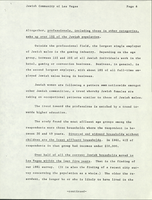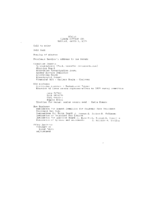Search the Special Collections and Archives Portal
Search Results
Henry Kronberg Papers
Identifier
Abstract
The Henry Kronberg Papers is comprised of photographs, newspaper clippings, and business records from 1945 to 2017 that document Henry Kronberg's business, Stoney's Pawn Shop, his personal life, and his involvement with the Jewish community in Las Vegas, Nevada. The collection also includes
Archival Collection
Maureen Mackey Papers
Identifier
Abstract
This collection is comprised of personal papers and photographs of Reverend Maureen E. Mackey, M.D., physiatrist and co-founder of Rainbow Praise Church in Las Vegas, Nevada. The collection contents span the dates of 1922 to 2014 and details Dr. Mackey's life, including her educational accomplishments, personal life, and religious life. This collection also contains personal papers and photographs of Dr. Mackey's twin brother, Thomas Mackey, III, who passed away from AIDS in 1992. This collection also contains various photographs of Dr. Mackey's parents and family.
Archival Collection
Junior League of Las Vegas Photograph Collection
Identifier
Abstract
The Junior League of Las Vegas Photograph Collection contains photographic prints and negatives, as well as postcards of locations in and around Las Vegas, Nevada between approximately 1900 and 1980. Early photographs in the collection offer views of the Las Vegas townsite, buildings, railroads, the Las Vegas High School, Overland Hotel, Arizona Club, and residential areas. Other photographs during this time depict the Hoover Dam (Boulder Dam) construction and Death Valley, California. Later photographs show the University of Nevada, Las Vegas (UNLV) campus, downtown Las Vegas, and the Las Vegas Strip.
Archival Collection

Transcript of interview with Alfred "Al" Isola by Stephen Kalish, March 15, 1976
Date
Archival Collection
Description
On March 15, 1976, Stephen Kalish interviewed Alfred “Al” Isola (born August 3rd, 1917 in Oakland, California) in his office about his garbage company and early Southern Nevada. The two discuss Las Vegas’ lack of a unified garbage system and how dumping sites have had to adjust their practices in order to limit their impact on pollution. Isola also explains the different disposal protocols for wet and dry trash. On the second tape of the interview, an unidentified woman enters the conversation.
Text

Transcript of interview with Clifford Kemple by Paul Wilkins, April 4, 1976
Date
Archival Collection
Description
On April 4, 1976, Paul Wilkins interviewed former miner Clifford Kemple (born September 28th, 1909 in Salt Lake City, Utah) in his home in Las Vegas, Nevada. The two discuss Kemple’s early life in Goodsprings, Nevada and Las Vegas, Nevada. Kemple also talks about changes that he has noticed in Las Vegas more broadly.
Text

Transcript of Interview with Merna Dennison by Ken Pyatt, March 1, 1980
Date
Archival Collection
Description
Text

Article, The Jewish Community of Las Vegas by Jerry Countess, September 1987
Date
Archival Collection
Description
In this essay, Jerry Countess provides narrative context for a demographic study of the Jewish population in Las Vegas, and addresses the services and community needs revealed by the study and the growing Jewish population.
Text

Meeting minutes for Consolidated Student Senate, University of Nevada, Las Vegas, March 5, 1974
Date
Archival Collection
Description
Text

Mike Meade interview, February 28, 1977: transcript
Date
Archival Collection
Description
On February 28, 1977, collector Steve Gortz interviewed Mike Meade (b. September 16, 1950 in San Francisco, California) about his life in Nevada. Meade speaks about growing up in Tonopah, Nevada before its decline in population, his move to Elko, Nevada and eventually to the city of Las Vegas. Moreover, he talks about the development of the Strip, the differences between Las Vegas and rural Nevada, as well as the changing environmental landscape. Meade also spends time discussing the controversy surrounding the University of Nevada, Las Vegas (UNLV) dormitory at the time of this interview, the attitude of locals, and his opinion on brothels and prostitution. Lastly, Meade talks about the city’s pollution, the sports and recreation throughout the whole of the state and ends by reading a poem about Nevada from a Bicentennial book.
Text

Transcript of interview with Marie Jordan by Danny Budak, March 20, 1978
Date
Archival Collection
Description
On March 20, 1978, collector Danny Budak interviewed the University of Nevada Las Vegas (UNLV) bookstore buyer, Marie Jordan (born June 26th, 1940 in Arizona) in the UNLV library. This interview offers Marie Jordan’s personal perspective of life in Nevada, being a local resident for twenty years. Marie also discusses family life and changes that she has witnessed in the Valley.
Text
